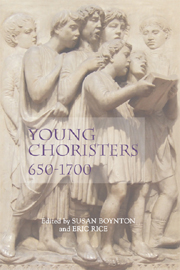Book contents
- Frontmatter
- Contents
- List of Illustrations
- List of Musical Examples
- Acknowledgements
- Dedication
- Introduction: Performance and Premodern Childhood
- 1 The Boy Singers of the Roman Schola Cantorum
- 2 Boy Singers in Medieval Monasteries and Cathedrals
- 3 The Musical Education of Young Girls in Medieval English Nunneries
- 4 Choirboys in Early English Religious Drama
- 5 From Mozos de coro towards Seises: Boys in the Musical Life of Seville Cathedral in the Fifteenth and Sixteenth Centuries
- 6 The Seeds of Medieval Music: Choirboys and Musical Training in a Late-Medieval Maîtrise
- 7 Choirboys in Cambrai in the Fifteenth Century
- 8 Choirboys and Vicaires at the Maîtrise of Cambrai: A Socio-anthropological Study (1550–1670)
- 9 Choirboys, Memorial Endowments and Education at Aachen's Marienkirche
- 10 Thomas Mulliner: An Apprentice of John Heywood?
- 11 Cantando tutte insieme: Training Girl Singers in Early Modern Sienese Convents
- 12 Choirboys in Early Modern Rome
- General Bibliography
- Index
10 - Thomas Mulliner: An Apprentice of John Heywood?
Published online by Cambridge University Press: 12 September 2012
- Frontmatter
- Contents
- List of Illustrations
- List of Musical Examples
- Acknowledgements
- Dedication
- Introduction: Performance and Premodern Childhood
- 1 The Boy Singers of the Roman Schola Cantorum
- 2 Boy Singers in Medieval Monasteries and Cathedrals
- 3 The Musical Education of Young Girls in Medieval English Nunneries
- 4 Choirboys in Early English Religious Drama
- 5 From Mozos de coro towards Seises: Boys in the Musical Life of Seville Cathedral in the Fifteenth and Sixteenth Centuries
- 6 The Seeds of Medieval Music: Choirboys and Musical Training in a Late-Medieval Maîtrise
- 7 Choirboys in Cambrai in the Fifteenth Century
- 8 Choirboys and Vicaires at the Maîtrise of Cambrai: A Socio-anthropological Study (1550–1670)
- 9 Choirboys, Memorial Endowments and Education at Aachen's Marienkirche
- 10 Thomas Mulliner: An Apprentice of John Heywood?
- 11 Cantando tutte insieme: Training Girl Singers in Early Modern Sienese Convents
- 12 Choirboys in Early Modern Rome
- General Bibliography
- Index
Summary
THIS CHAPTER will examine the further musical education and training of English choristers (after their voices had broken) between 1500 and 1560. It was customary to place the most talented young men in an apprenticeship with a master of choristers or a musician associated with a prominent ecclesiastical or collegiate institution. Using archival sources that document the activities of masters of choristers, the autobiographical manuscript produced by Thomas Whythorne, an apprentice of John Heywood from 1545 to 1548, and the famous miscellany by the singer and organist Thomas Mulliner, I will argue that Mulliner was in turn Heywood's apprentice from 1559 to 1563 and that he compiled his miscellany during that time.
Like Whythorne, who had been a chorister at Magdalen College School, Oxford, before he studied with Heywood, Mulliner had presumably trained as a chorister, although it is not known where. In general, such musical apprentices would have been expected to continue their study of pricksong, faburden, descant, organ-playing, and Latin grammar, and in addition, to serve their master by teaching younger choristers or by assisting in the production of pageants and other civic or royal entertainments. In this way, Whythorne learned from Heywood how to play dances and songs on the virginals and lute; how to write verse; and how to set lyrics to music.
- Type
- Chapter
- Information
- Young Choristers, 650–1700 , pp. 173 - 194Publisher: Boydell & BrewerPrint publication year: 2008



